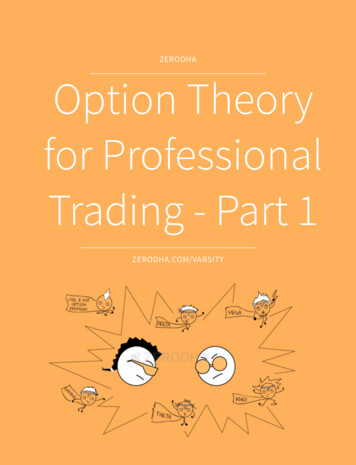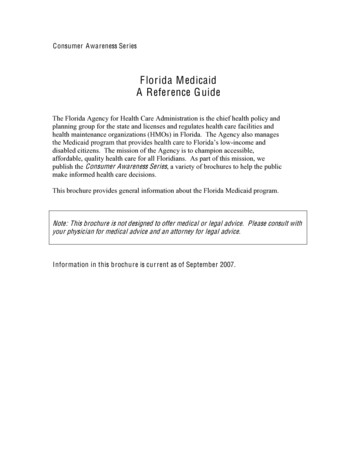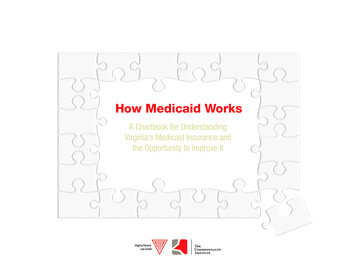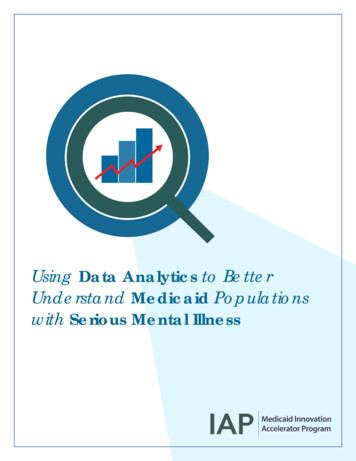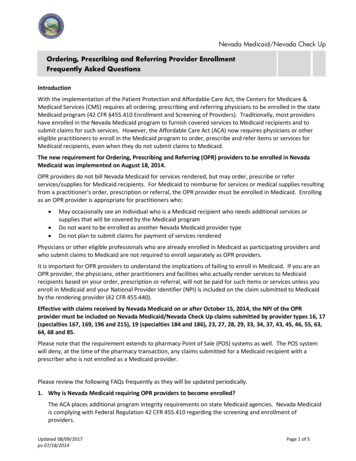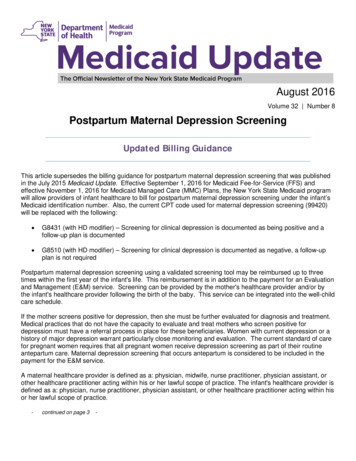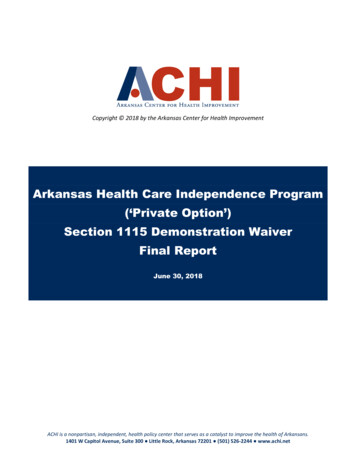
Transcription
Copyright 2018 by the Arkansas Center for Health ImprovementArkansas Health Care Independence Program(‘Private Option’)Section 1115 Demonstration WaiverFinal ReportJune 30, 2018ACHI is a nonpartisan, independent, health policy center that serves as a catalyst to improve the health of Arkansans.1401 W Capitol Avenue, Suite 300 Little Rock, Arkansas 72201 (501) 526-2244 www.achi.net
About the EvaluatorsThe Arkansas Center for Health Improvement (ACHI) is a nonpartisan, independent health policy center whosevision is to be a trusted health policy leader committed to innovations that improve the health of Arkansans. Thisvision is carried out through ACHI’s mission to be a catalyst for improving the health of Arkansans throughevidence-based research, public issue advocacy, and collaborative program development. In undertaking thismission, ACHI has worked hard to develop and adhere to an important set of values that guide the Center.ACHI’s core values are commitment, initiative, trust, and innovation. These are the fundamental principles thatguide the Center’s collective and individual decisions, strategies, and actions to advance the health of Arkansans.These core values define what ACHI — the organization and its people — stands for throughout time, regardlessof changes in ACHI’s internal structure and leadership, or in response to external factors and environmentalconditions.ACHI TeamJoseph W. Thompson, MD, MPH, DirectorAnthony Goudie, PhD, Director of Research and EvaluationNichole Sanders, PhD, Assistant Director of AnalyticsKanna Lewis, PhD, Health Policy Data ArchitectVanessa White, BA, Project CoordinatorStephen Lein, MS, Senior Data AnalystJudy Bennett, MS, Senior Research AnalystPader Moua, MPH, Policy AnalystTim Holder, BA, Technical EditorJohn Lyon, BA, Strategic Communications ManagerVaishali Thombre, MBA, MS, Senior Research AnalystJeral Self, MPH, Senior Data AnalystKenley Money, MA, MFA, Director of Information Systems ArchitectureUniversity of Arkansas for Medical Sciences Evaluators Anthony Goudie, PhDDirector of Research and Evaluation, Arkansas Center for Health ImprovementAssistant Professor, Center for Applied Research and Evaluation, Department of Pediatrics, College of Medicine,University of Arkansas for Medical SciencesAssistant Professor, Department of Health Policy and Management, Fay W. Boozman College of Public Health,University of Arkansas for Medical SciencesCopyright 2018 by the Arkansas Center for Health Improvement. All rights reserved.Arkansas Health Care Independence Program (‘Private Option’) Final Report
John “Mick” Tilford, PhDProfessor and Department Chair, Department of Health Policy and Management, Fay W. Boozman Collegeof Public Health, University of Arkansas for Medical SciencesProfessor, Department of Pharmaceutical Evaluation and Policy, College of Pharmacy, University ofArkansas for Medical Sciences Bradley Martin, PharmD, PhDProfessor, Division Head, Department of Pharmaceutical Evaluation and Policy, College of Pharmacy,University of Arkansas for Medical SciencesComparative Effectiveness Research Program Co-Director, Translational Research Institute, University ofArkansas for Medical Sciences Teresa Hudson, PharmD, PhDAssociate Professor of Psychiatry and Director, Division of Health Services Research, College of Medicine,University of Arkansas for Medical SciencesDirector, National Rural Evaluation Center, U.S. Department of Veterans AffairsAssociate Director, Center for Mental Healthcare and Outcomes Research, U.S. Department of Veterans Affairs Jeffrey Pyne, MDProfessor, Department of Psychiatry and Behavioral Sciences, College of Medicine, University of Arkansasfor Medical SciencesAssociate Professor, Department of Pharmacy Practice, College of Pharmacy, University of Arkansas forMedical SciencesAssociate Professor, Department of Epidemiology, College of Public Health, University of Arkansas forMedical SciencesStaff Physician, Central Arkansas Veterans Healthcare SystemAssociate Director for Research and Site Leader for Community Engagement, South Central (VISN 16)Mental Illness Research, Education, and Clinical CenterResearch Health Scientist and Core Investigator, Center for Mental Healthcare and Outcomes Research,U.S. Department of Veterans Affairs Chenghui Li, PhDAssociate Professor, Division of Pharmaceutical Evaluation and Policy, College of Pharmacy, University ofArkansas for Medical Sciences Nalin Payakachat, PhDAssociate Professor, Division of Pharmaceutical Evaluation and Policy, College of Pharmacy, University ofArkansas for Medical SciencesCopyright 2018 by the Arkansas Center for Health Improvement. All rights reserved.Arkansas Health Care Independence Program (‘Private Option’) Final Report
UAMS Research Support TeamGary Moore, MS, Research AnalystXiaotong Han, MS, BiostatisticianNiranjan Kathe, MS, Graduate Research AssistantDivyan Chopra, MS, Graduate Research AssistantNaleen Raj Bhandari, MS, Graduate Research AssistantMahip Acharya, B Pharm, Graduate Research AssistantAcknowledged ContributorsHeather L. Rouse, MSEd, PhDBrady Rice, BSGrayson Shelton, BSDonald Poe, BSAnuj Shah, PhDSiqing Li, MSCopyright 2018 by the Arkansas Center for Health Improvement. All rights reserved.Arkansas Health Care Independence Program (‘Private Option’) Final Report
AcknowledgementsPrivate Option Evaluation National Advisory CommitteeThe purpose of the National Advisory Committee (NAC) is to act as an external expert advisory group for theArkansas Section 1115 demonstration waiver evaluation. Members of the committee were asked to serve in thecapacity for the duration of the three-year evaluation period (2014-2017) and were selected based on their contentexpertise and methodological experience. The committee is comprised of a diverse range of policy perspectives andprofessional backgrounds. Eduardo Sanchez, MD, MPH, Chief Medical Officer (CMO) for Prevention, American Heart Association NationalCenter Darrell J. Gaskin, PhD, Deputy Director, Center for Health Disparities Solutions, Bloomberg School of PublicHealth, Johns Hopkins University Daniel Polsky, PhD, Executive Director, Leonard Davis Institute of Health Economics, University of Pennsylvania Timothy S. Carey, MD, MPH, Sarah Graham Kenan Professor of Medicine, Departments of Medicine and SocialMedicine, School of Medicine, University of North Carolina at Chapel HillCorrespondence concerning this report should be addressed to the Arkansas Center for Health Improvement(ACHI).Contributing ACHI authors include Joseph W. Thompson, MD, MPH, and Anthony Goudie, PhD.Suggested CitationArkansas Center for Health Improvement. Arkansas Health Care Independence Program (‘Private Option’)Section 1115 Demonstration Waiver Final Report. Little Rock, AR: Arkansas Center for Health Improvement, June2018.Copyright 2018 by the Arkansas Center for Health Improvement. All rights reserved.Arkansas Health Care Independence Program (‘Private Option’) Final Report
AbbreviationsACHIArkansas Center for Health ImprovementAHAThe Arkansas Hospital AssociationAHRQAgency for Healthcare Research and QualityAIDArkansas Insurance DepartmentAVActuarial ValueBNCBudget Neutrality CapCAHPSConsumer Assessment of Healthcare Providers and SystemsCASTCenter for Advanced Spatial TechnologiesCDCCenters for Disease Control and PreventionCMSCenters for Medicare & Medicaid ServicesCPTCurrent Procedure TerminologyCSRCost-Sharing ReductionCYCalendar YearDCODepartment of County OperationsDHSArkansas Department of Human ServicesEHBEssential Health BenefitEPSDEarly and Periodic Screening and DiagnosticEREmergency RoomFFMFederally Facilitated MarketplaceFFSFee-For-ServiceFPLFederal Poverty LevelFQHCFederally Qualified Community Health CenterGMEGraduate Medical EducationHbA1cHemoglobin A1cHCIPHealth Care Independence ProgramHEDISHealthcare Effectiveness Data and Information SetHIAHealth Independence AccountsLATELocal Average Treatment EffectLDL-cLipoproteinLSMLeast Squares MeanCopyright 2018 by the Arkansas Center for Health Improvement. All rights reserved.Arkansas Health Care Independence Program (‘Private Option’) Final Report
MarketplaceIndividual Health Insurance MarketplaceMDESMinimum Detectable (standardized) Effect SizeMEPSMedical Expenditure Panel SurveyMLRMedical Loss RatioNACNational Advisory CommitteeNCQANational Committee for Quality AssuranceNEMTNon-Emergency Medical TransportationNQFNational Quality ForumNYUNew York UniversityPCCMPrimary Care Case ManagementPCPPrimary Care ProviderPMPMPer Member Per MonthPMPYPer Member Per YearPPACAPatient Protection and Affordable Care ActPYPerson-YearsPY1Program Year 1PY2Program Year 2PY3Program Year 3QHPQualified Health PlanQuestionnaireHealthcare Needs Assessment QuestionnaireRCTRandomized Controlled TrialRDRegression DiscontinuityRERelative EfficiencyRUCARural-Urban Commuting Area CodeSIPTWStabilized Inverse Probability of Treatment WeightingSNAPSupplemental Nutrition Assistance ProgramSSISocial Security IncomeTEFRATax Equity and Fiscal Responsibility ActUAMSUniversity of Arkansas for Medical SciencesUPLUpper Payment LimitCopyright 2018 by the Arkansas Center for Health Improvement. All rights reserved.Arkansas Health Care Independence Program (‘Private Option’) Final Report
Table of ContentsExecutive Summary . iBackground . iSummary of Findings Based on Evaluation Hypotheses . iConclusion. viIntroduction . 1Background . 1Arkansas Profile . 1Arkansas Structure of Commercial Premium Assistance . 2Arkansas Structure of PPACA Eligibility and Enrollment . 3Arkansas HCIP Program Experience . 6Arkansas HCIP Evaluation Strategy . 8Research Design and Approach . 9Goals and Objectives. 9Programmatic Timeline and Reporting Requirements . 10Theoretical Approach. 11Hypotheses . 13Data Sources and Analytic Comparison Groups . 14Methodological Approaches . 16The First Year Experience. 18Year 2 and Year 3 Waiver Impact Findings . 24Introduction to Analyses . 24Geographic and Realized Access Differences and Provider Reimbursement Comparisonbetween Medicaid and QHP Programs. 27Differences in Comparison Groups by Comparison Populations . 31Special Populations and Topic Studies. 43Program Costs . 71Overview . 71Cost-Effectiveness . 72Program Impact Simulation . 73Appendices . A-1Appendix A – Arkansas Evaluation Hypotheses: Proposed and Original Test Indicators . A-1Appendix B – Arkansas Evaluation Hypotheses .B-1Appendix C – Data Processing of Carrier Data .C-1Appendix D – Study Subjects: Analytical Sample Extraction . D-1Copyright 2018 by the Arkansas Center for Health Improvement. All rights reserved.Arkansas Health Care Independence Program (‘Private Option’) Final Report
Appendix E – Statistical Modeling to Assess Effect Differences for Those Assigned to Medicaid and QHPs . E-1Appendix F – Supplemental Payments, Claims Loading Process, and Per Member Per Month Logic . F-1Appendix G – Geographic Information System (GIS) Processing . G-1Appendix H – Weighted Average Price Calculations. H-1Appendix I – Pregnancy Analytic Profile . I-1Appendix J – Opioid Use Outcomes . J-1Appendix K – Consumer Assessment of Healthcare Providers and Systems (CAHPS) Sample SizeCalculation, Sampling Strategy, and Data Preparation . K-1Table of FiguresFigure 1. HCIP Premium and Cost-Sharing Reduction Breakdown . 3Figure 2. Enrollment Pathways and Plan Assignment Process . 4Figure 3. HCIP Monthly Enrollment, January 2014–December 2016 . 6Figure 4. Enrollment Age Demographics by Category . 7Figure 5. Premium and Cost-Sharing Reduction Breakdown, January 2014–December 2016 . 8Figure 6. Arkansas Demonstration Waiver Evaluation Logic Model. 9Figure 7. Arkansas Health Care Independence Program Period: System Evaluation . 10Figure 8. Proportion of Medicaid and QHP Enrollees with a First Outpatient Care Visit, by Day . 31Figure 9. Health Care Independence Program Enrollment by Program and Month . 52Figure 10. Charlson Comorbidity Index by Health Independence Account Non-Participants(Made No Payment) vs. Participants (Made Payment) . 56Figure 11. Access Improvement Simulation Model Studying Scenario-Based Price Increasesto Medicaid Providers to Reach Commercial PMPM Payments . 75Table of TablesTable 1. Comparison Group Description and Analytical Data Populations . 15Table 2. Differences in General Population Geographic Access to Health Care between Medicaid and QHPEnrollees . 28Table 3. Differences in Higher Needs Population Geographic Access to Health Care between Medicaid andQHP Enrollees . 29Table 4. Medicaid and Commercial Payer Price Differences for Outpatient Procedures by Provider Type . 30Table 5. Differences in Perceived Access to Health Care between Medicaid and QHP Enrollees (PropensityScore Matched Comparison) . 32Table 6. Differences in Primary Preventive Health Care between Medicaid and QHP Enrollees (PropensityScore Matched Comparison) . 32Table 7. Differences in Secondary and Tertiary Preventive Health Care between Medicaid and QHP Enrollees(Propensity Score Matched Comparison) . 33Table 8. Differences in the Percentage of Medicaid and QHP Enrollees Receiving Recommended DiseaseManagement (Propensity Score Matched Comparison) . 34Table 9. Differences in the Use of Healthcare Services between Medicaid and QHP Enrollees (PropensityScore Matched Comparison) . 35Copyright 2018 by the Arkansas Center for Health Improvement. All rights reserved.Arkansas Health Care Independence Program (‘Private Option’) Final Report
Table 10. Differences in Rates of Preventable Hospitalizations and Readmissions between Medicaid andQHP Enrollees (Propensity Score Matched Comparison) . 36Table 11. Differences in Utilization of Emergency Room Services between Medicaid and QHP Enrollees(Propensity Score Matched Comparison) . 36Table 12. Differences in Perceived Access to Health Care between Medicaid and QHP Enrollees (RegressionDiscontinuity Comparison) . 37Table 13. Differences in Primary, Secondary, and Tertiary Preventive Health Care between Medicaid andQHP Enrollees (Regression Discontinuity Comparison . 38Table 14. Differences in Secondary and Tertiary Preventive Health Care between Medicaid and QHP Enrollees(Regression Discontinuity Comparison) . 39Table 15. Differences in the Percentage of Medicaid and QHP Enrollees Receiving Recommended DiseaseManagement (Regression Discontinuity Comparison) . 40Table 16. Differences in the Use of Healthcare Services between Medicaid and QHP Enrollees (RegressionDiscontinuity Comparison) . 41Table 17. Differences in Rates of Preventable Hospitalizations and Readmissions between Medicaid andQHP Enrollees (Regression Discontinuity Comparison) . 42Table 18. Differences in Utilization of Emergency Room Services between Medicaid and QHP Enrollees(Regression Discontinuity Comparison) . 43Table 19. Maternal Pregnancy and Birth Outcomes, with Description . 44Table 20. Maternal Pregnancy Differences between Medicaid and QHP Enrollees . 46Table 21. Pregnancy Birth Outcomes between Medicaid and QHP Enrollees . 46Table 22. Differences in Non-Emergency Transportation between General Population Medicaid and QHPEnrollees . 48Table 23. Differences in Non-Emergency Transportation between Medicaid and QHP Enrollees (PropensityScore Matched Comparison) . 48Table 24. Differences in Non-Emergency Transportation between Higher Needs Population Medicaid andQHP Enrollees . 48Table 25. Differences in Non-Emergency Transportation between Medicaid and QHP Enrollees (RegressionDiscontinuity Comparison) . 49Table 26. Health Insurance Carrier at 19 Years of Age for Medicaid Screened and Diagnosed Sickle CellDisease, Cystic Fibrosis, or Hemophilia (n 151) . 50Table 27. Medicaid Enrollment History of QHP and 06 Medicaid Individuals Enrolled in June 2015 . 53Table 28. The Impact of Redetermination on QHP and 06 Medicaid Enrollees (Enrolled in July 2015) . 53Table 29. HCIP Enrollment History of Individuals Enrolled in HCIP During 2016. 54Table 30. Health Independence Account Eligible Population Demographic Profile. 56Table 31. Health Independence Accounts Cost-Sharing Expenditures. 56Table 32. Characteristics of Unmatched and Propensity Score Matched General Population . 59Table 33. Opioid Use Measures for Propensity Score Matched General Population Medicaid and QHP byAssessment Period . 60Table 34. Comparison of Opioid Utilization for General Population Medicaid and QHP Enrollees . 60Table 35. Comparison of Number of Opioid Prescriptions by General Population Medicaid and QHP(Reference) Enrollees. 61Table 36. Characteristics of Higher Needs Population . 62Table 37. Opioid Use Measures for Propensity Score Matched Higher Needs Population Medicaid and QHP byAssessment Period . 62Table 38. Comparison of Opioid Utilization for Medicaid and QHP Higher Needs Population Enrollees . 63Copyright 2018 by the Arkansas Center for Health Improvement. All rights reserved.Arkansas Health Care Independence Program (‘Private Option’) Final Report
Table 39. Change in Estimated Rate of Non-Emergent Emergency Room Visits per 100 Person-Years . 64Table 40. Unadjusted Analysis of Urgent Care Facility Utilization and Cost. 65Table 41. Medicaid and QHP Enrollee General Population Propensity Score Matched Characteristics . 67Table 42. Medicaid and QHP Enrollees General Population Propensity Score Matched Characteristics . 69Table 43. Observed Utilization Rates (Per Member Per 100 Person-Years) for Medicaid and QHP Enrollees in2014, 2015, and 2016 . 71Table 44. Observed and Estimated PMPM Cost Scenarios for Medicaid and QHP Enrollees by ServiceCategory and Year. 73Copyright 2018 by the Arkansas Center for Health Improvement. All rights reserved.Arkansas Health Care Independence Program (‘Private Option’) Final Report
Executive SummaryBackgroundIn 2013, like many other states across the country, Arkansas faced a complex series of political challengesfollowing the U.S Supreme Court decision on the Patient Protection and Affordable Care (PPACA) Act. Unlike anyother state in the South, however, Arkansas was able to successfully navigate these challenges to pursue a novelapproach to Medicaid expansion through the commercial sector. Through a Section 1115 demonstration waiver,the state utilized premium assistance to secure private health insurance, offered on the newly formed individualhealth insurance marketplace (the Marketplace), for individuals between 19 and 64 years of age with incomes ator below 138 percent of the federal poverty level (FPL). iIn 2014, Arkansas successfully established the Health Care Independence Program (HCIP),ii commonly referred toas the “Private Option,” as designed under the terms and conditions of the Section 1115 demonstration waiver.Through 2015, the estimated target-enrollment population of approximately 250,000 was met. Approximately25,000 additional individuals eligible under the PPACA — and deemed to have exceptional healthcare needs —were enrolled in the traditional Medicaid program. Finally, approximately 20,000 previously eligible but newlyenrolled individuals also obtained Medicaid coverage. By the end of 2016, the Private Option population totaledapproximately 280,000.Arkansas’s healthcare providers have reported significant clinical and financial effects under the HCIP. In 2014,federally qualified community health centers (FQHCs) reported increased success in attaining needed specialtyreferrals for their clients.iii The Arkansas Hospital Association (AHA) reported significant annualized reductions inuninsured outpatient visits (45.7 percent reduction), emergency room (ER) visits (38.8 percent reduction), andhospital admissions (48.7 percent reduction).iv The state’s public teaching hospital reported a reduction in uninsuredadmissions, from 16 percent to 3 percent, during the same time period.v These reductions persisted through 2016.Competitiveness and consumer choice in the Marketplace have increased across the seven market regions in thestate with approximately 80 percent of the covered lives in the Marketplace enrolled through the Private Option.In 2014, individuals in three out of the seven regions of the state — those marked by extreme poverty — only hadaccess to Arkansas Blue Cross and Blue Shield and Blue Cross Blue Shield Multi-State plans. By 2016, five carrierswere offering coverage across all seven market regions, with one market region having access to six carriers. Asixth carrier operated in a single region restricted by Medicaid’s purchasing guidance limiting premium assistanceto those plans within 10 percent of the second-lowe
Arkansas Health Care Independence Program ('Private Option') Final Report Acknowledgements Private Option Evaluation National Advisory Committee The purpose of the National Advisory Committee (NAC) is to act as an external expert advisory group for the Arkansas Section 1115 demonstration waiver evaluation.

